To me, capital growth and dividend income are equally important. Together, they provide the total return from any share investment and, as you might expect, my aim is to invest in companies that can beat the total return delivered by the wider market.
To put that aim into perspective, the FTSE 100 has provided investors with a total return of around 3% per annum since January 2008.
Quality and value
If my investments are to outperform, I need to back companies that score well on several quality indicators and buy at prices that offer decent value.
Should you invest £1,000 in Ishares Public Limited Company - Ishares Euro Dividend Ucits Etf right now?
When investing expert Mark Rogers has a stock tip, it can pay to listen. After all, the flagship Motley Fool Share Advisor newsletter he has run for nearly a decade has provided thousands of paying members with top stock recommendations from the UK and US markets. And right now, Mark thinks there are 6 standout stocks that investors should consider buying. Want to see if Ishares Public Limited Company - Ishares Euro Dividend Ucits Etf made the list?
So this series aims to identify appealing FTSE 100 investment opportunities and today I’m looking at Randgold Resources Ltd (LSE: RRS) (NASDAQ: GOLD.US), the Africa-focused gold miner and explorer.
With the shares at 4,466p, Randgold’s market cap. is £4,119 million.
This table summarises the firm’s recent financial record:
| Year to December | 2008 | 2009 | 2010 | 2011 | 2012 |
|---|---|---|---|---|---|
| Revenue ($m) | 374 | 477 | 506 | 1,127 | 1,318 |
| Net cash from operations ($m) | 58 | 64 | 108 | 582 | 494 |
| Adjusted earnings per share (cents) | 54 | 86 | 114 | 420 | 470 |
| Dividend per share (cents) | 13 | 17 | 20 | 40 | 50 |
The recent interim results statement showed that Rangold sold around 0.2% more ounces of gold than during the equivalent period last year. Meanwhile, production itself was up around 5%, and both theses figures demonstrate that the firm continues to progress operationally with its gold exploration and mining activities.
That’s scant consolation for investors, though. The firm realised a 9% lower average price per ounce for its gold sales this year compared to last year. That doesn’t seem much of a reduction, but it has contributed to these figures: profit down 45% and net cash from operations down 60%. Clearly, the price of gold is important to Randgold and its investors.
The company’s CEO reckons Randgold has designed the business model to deliver returns at lower gold prices, which has prevented the need to write down its reserves, calculated at a gold price of US$1 000/oz. However, he confirmed that the firm has reviewed its business plans in light of lower gold prices.
So where do you think the price of gold is going? It’s an essential question to consider if you are thinking of investing in Randgold and a question that I can’t answer, which keeps me out of the shares.
Randgold’s total-return potential
Let’s examine five indicators to help judge the quality of the company’s total-return potential:
1. Dividend cover: adjusted earnings covered last year’s dividend over nine times. 5/5
2. Borrowings: the most recent balance sheet revealed the firm is carrying net cash. 5/5
3. Growth: steady growth from revenue and earnings with cash flow slipping last year. 3/5
4. Price to earnings: a forward 17 looks towards profit recovery during 2014. 3/5
5. Outlook: difficult recent trading and a cautiously optimistic outlook. 3/5
Overall, I score Randgold 19 out of 25; however, the total-return outlook is uncertain and dependent on the gold price.
Foolish Summary
Although dividend cover is good, the forward dividend yield is only about 0.7%. The company is flush with cash, which could be handy if the price of gold continues to fall. Until recently, earnings growth has been steady. The valuation seems to anticipate a return to higher gold prices.







